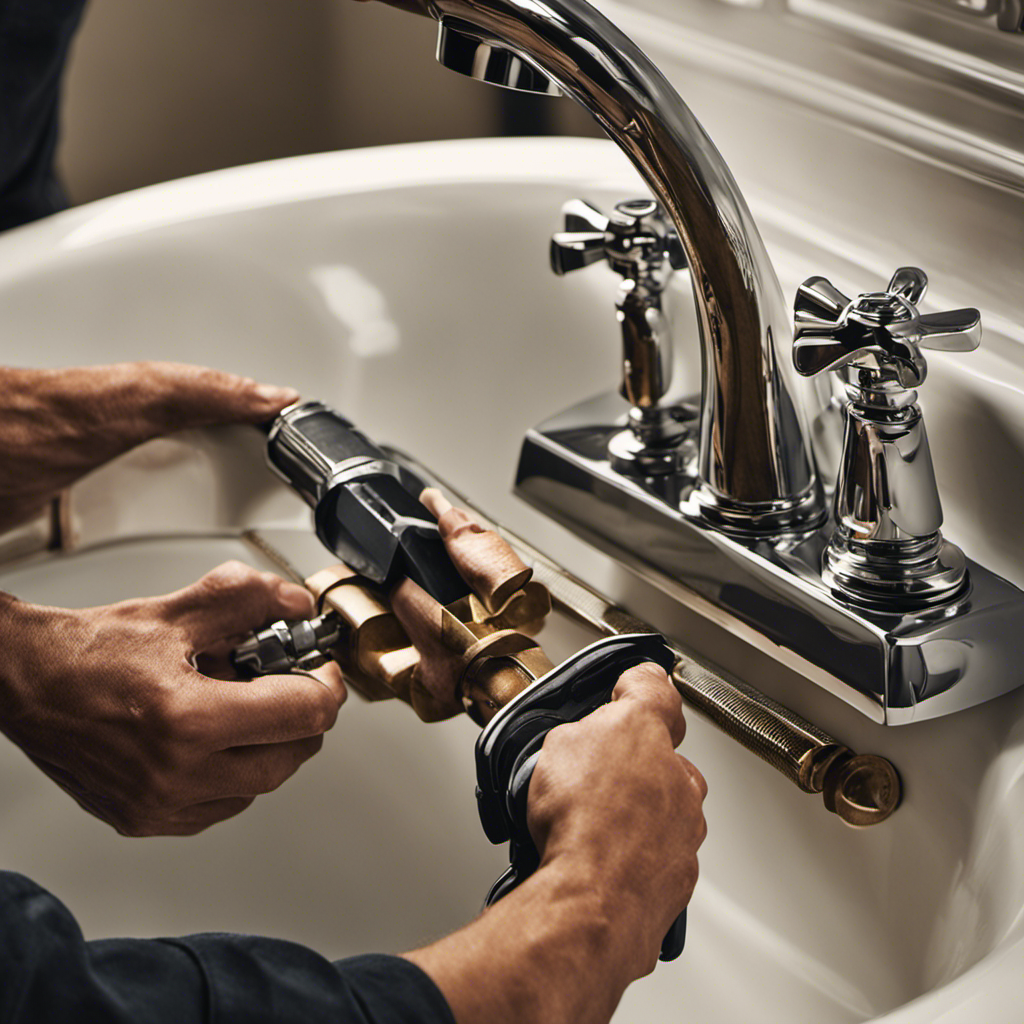Like a leaky faucet in the dead of night, that unsightly gap between your floor and bathtub can be a constant reminder of the need for a fix. But fear not, because I’m here to guide you through the steps to solve this problem once and for all.
In this article, I will show you how to:
- Identify the cause of the gap
- Assess its severity
- Gather the necessary tools and materials
- Fill the gap with sealant or caulk
Say goodbye to that pesky gap, and hello to a beautifully sealed bathroom.
Key Takeaways
- Improper installation and inadequate sealing materials can lead to gaps.
- Assess the size of the gap to determine the seriousness of the issue.
- Significant gaps can lead to water damage and structural issues.
- Choose a sealant specifically designed for wet areas like bathrooms.
Identify the Cause of the Gap
First, you’ll want to figure out what’s causing the gap between your floor and bathtub. Identifying the cause is crucial in order to fix the problem effectively.
There are a few common causes of water damage and gaps in bathtub installations. One possible cause is improper installation, where the bathtub was not securely attached to the floor. This can lead to shifting and gaps over time.
Another common mistake is using inadequate sealing materials, such as low-quality caulk or adhesive, which can deteriorate and cause gaps.
Additionally, water damage from leaks or plumbing issues can also contribute to the gap. By understanding the causes, you can take the necessary steps to fix the problem.
Now, let’s move on to assessing the severity of the gap.
Assess the Severity of the Gap
To determine how serious the issue is, you should assess the size of the gap between the floor and the bathtub. This is important because it will help you understand the potential safety hazards and the long-term effects on the bathtub and floor structure.
A larger gap may indicate a more severe problem, such as a weakened floor or a damaged bathtub support. This can pose a safety risk, especially if the gap is near the edge of the bathtub where someone could trip and fall.
Additionally, a significant gap can lead to water damage and structural issues over time. It’s crucial to address this issue promptly to prevent further damage and ensure the safety and stability of your bathroom.
Gather the Necessary Tools and Materials
Once you have gathered all the necessary tools and materials, you can start addressing the issue of the gap between the floor and the bathtub.
The first step is to choose the right sealant for the job. Look for a sealant that is specifically designed for use in wet areas, such as bathrooms, and that is also flexible to accommodate any movement between the floor and the bathtub. Silicone sealants are a popular choice for this type of application.
Once you have your sealant, make sure to read the instructions carefully before starting. Proper application techniques are crucial to ensure a long-lasting and effective seal.
Clean the area thoroughly, apply the sealant in a continuous bead along the gap, and smooth it out using a caulking tool or your finger.
Allow the sealant to dry completely before using the bathtub.
Fill the Gap With Sealant or Caulk
Before applying the sealant, I always make sure that the area is clean and dry. This is crucial for a successful application.
When it comes to filling the gap between the floor and bathtub, using a waterproof sealant or caulk is a practical and effective solution. These waterproofing solutions help prevent water leakage and protect against potential damage to the floor or surrounding areas.
It is important to choose a high-quality sealant that is specifically designed for bathroom use. Professional bathtub installation often includes the application of sealant to ensure a watertight seal.
Finishing Touches and Preventative Measures
I always ensure that the sealant or caulk I choose is waterproof and specifically designed for bathroom use. This is crucial for preventing future gaps in your bathroom and maintaining a clean and watertight seal around your bathtub. When it comes to choosing the right bathtub finish, there are a few options to consider. One popular choice is a porcelain finish, which is durable, easy to clean, and resistant to stains and scratches. Another option is an acrylic finish, which is lightweight and available in a variety of colors and styles. Finally, there is the option of a fiberglass finish, which is affordable and easy to install. Each finish has its own advantages and it’s important to choose one that suits your personal preferences and budget. To make it easier for you to compare the different finishes, I have created a table below:
| Finish | Advantages | Disadvantages |
|---|---|---|
| Porcelain | Durable, easy to clean | Expensive |
| Acrylic | Lightweight, variety of colors | Prone to scratches |
| Fiberglass | Affordable, easy to install | Less durable, can fade over time |
Conclusion
So there you have it, folks! Fixing the gap between your floor and bathtub is a simple and practical task that can be done with a little bit of effort.
By identifying the cause of the gap, assessing its severity, and gathering the necessary tools and materials, you’ll be well on your way to a perfectly sealed bathroom.
Fill the gap with sealant or caulk, and don’t forget those finishing touches and preventative measures.
Trust me, once you’ve completed this task, your bathroom will be as snug as a bug in a rug!










